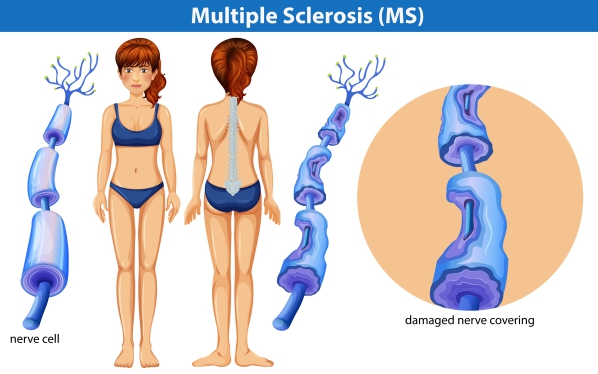Multiple sclerosis, Neurological disorder, Spinal cord, Visual problems, L'hermitte sign
Description : Multiple sclerosis (MS) is a disease that affects the brain and spinal cord. The immune system
Article Details :
What is multiple sclerosis?
Multiple sclerosis (MS) is a disease that affects the brain and spinal cord. The immune system attacks the myelin sheath which is a protective layer that covers the nerve fibres, resulting in significant physical disability. The hallmark of MS is symptomatic episodes that affects different organs or structure of the body occurring over months or years apart.
According to the National Multiple Sclerosis Society in the United States, there are about 400,000 people affected by MS. In addition, women are more commonly affected by MS than men. MS can occur in people of any age but is more common in people aged between 15-45 years. Unfortunately, there is no cure for MS. However, there are several treatment options available to relieve your symptoms and increase the rate of recovery from symptomatic episodes.
What are the risk factors for multiple sclerosis?
There are several factors which may increase your risk of developing MS and these include:
- Family history: having a parent or sibling affected by MS increases your risk of developing MS.
- Age: MS affects people of all ages but is more common in people aged between 15-45 years.
- Sex: women are more commonly affected by MS than men.
- EBV infection: this virus causes a disease known as infectious mononucleosis and can increase your risk of developing MS.
- Race: whites are at increased risk of developing MS compared to Asian and African people.
- Smoking: cigarette smoking may increase your risk of developing MS.
- Vitamin D deficiency: having little sun exposure or low levels of vitamin D may increase your risk of developing MS.
Classification of multiple sclerosis
MS can be classified into:
- Relapsing-remitting MS: in this type of MS, your symptomatic episodes are usually followed by complete or partial recovery and in between these episodes, your condition remains stable.
- Secondary progressive MS: initially this type follows the same course as relapsing-remitting MS but then your symptoms become gradually worse and the symptom-free periods decrease.
- Primary progressive MS: in this type of MS, your symptoms worsens progressively as from its onset and there is no symptom-free period.
- Progressive-relapsing MS: in this type of MS, your symptoms gradually progress from its onset and there are periods during which your symptoms resolves partially. However, your condition will continue to worsen progressively.
What are the signs and symptoms of multiple sclerosis?
The signs and symptoms of MS vary depending on which nerves are being affected. The signs and symptoms of MS include:
- Sensory loss
- Muscle cramping
- Bladder, bowel and sexual dysfunction
- Slurred speech
- Loss of vision
- Pain on movement of the affected eye
- Transient flashes of light
- Blurry vision
- Double vision
- Irregular twitching of the facial muscles
- Heat intolerance
- Fatigue
- Dizziness
- Depression
- Inability to sleep
- Memory and concentration problems
- Electric-like sensations that occur with some neck movement. This is known as the L’hermitte sign
- Numbness or weakness of your limbs on one side
- Seizures
- Rigid limbs that affects range of movement

Making a diagnosis
To make the diagnosis of MS, your doctor will take a detailed history from you to know more about your symptoms. He/she will use the McDonald’s criteria which consists of a combination of clinical, imaging and additional tests to help confirm the diagnosis of MS. Following the history taking, your doctor will perform a thorough physical examination to look for signs of MS. The history taking and physical examination are very important for the diagnosis of MS as the hallmark of the disease is to have symptoms occuring at different locations of the body which is separated by a period of time. To confirm the diagnosis of MS, your doctor may order some tests and these include:
- Blood studies: blood tests are usually normal in people affected by MS. However, these tests are done to rule out other diseases such as vitamin B12 deficiency, sarcoidosis and endocrine abnormalities amongst others.
- Magnetic Resonance Imaging (MRI) scan: MRI is the imaging of choice to confirm the diagnosis of MS and monitor the disease progression. It shows lesions in your brain or spinal cord.
- Computed tomography (CT) scan or angiography: CT scans are mainly used to rule out bony lesions and angiography to rule out central nervous system vasculitis.
- Lumbar puncture: this test involves your doctor inserting a needle in between your vertebrae to get access to the fluids (cerebrospinal fluid) surrounding your spinal cord. It is used when MRI scan is unavailable or its findings are Read more





